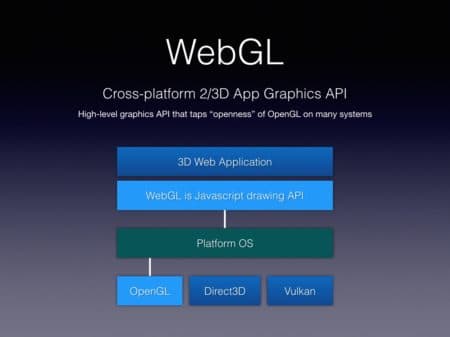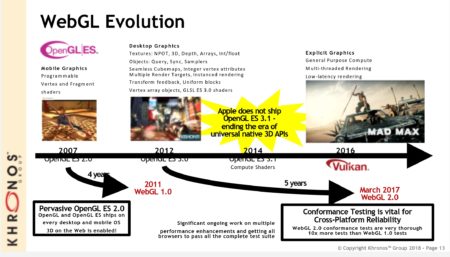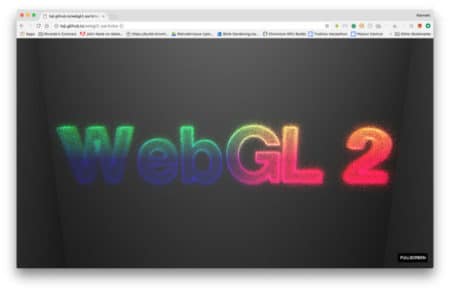HERE AT ARCHITOSH, we have had a long history of focusing on not just the CAD and 3D applications that make the AEC and manufacturing industries go around, but the core technologies that are behind these applications. Few core technologies, if any, are as vital in the current era as WebGL.
Why WebGL—Its Importance
WebGL is hugely important for several reasons. As a technology, it is a “plugin-free” 3D graphics technology for the modern web browser. The Internet has a long history of attempts at 3D graphics in browsers via plugins, but users, in general, are not particularly adept at managing the plugin process and the process of installing plugins are disruptive to contemporary expectations around business workflows. So no plugins.

01 – WebGL 1.0 is currently highly utilized and enables professional apps like Onshape and Frame to run in modern web browsers across many operating systems. It works well because it taps into the openness of OpenGL. WebGL 2.0 will propel this standard and drive innovation across all types of professional 3D apps on the web.
WebGL is also based on OpenGL ES, a hugely successful open industry standard for portable graphics that works across every computer operating system of significance. While there has been a massive explosion of 3d capabilities in hardware across devices of all types—from workstations to smartphones—, the web browser itself hasn’t been a major consideration for a 3D application target for developers until the Khronos Group established the WebGL Working Group and a set of development standards.
WebGL History
WebGL 1.0 was launched in 2011, the year the Apple iPad began to see significant interest in enterprise industries like AEC. Heralded as a cross-platform, royalty-free web standard that brings high-quality 3D graphics to the web browser with plugins, WebGL has taken off. It is by far the most widely used web graphics API on the market and is universally supported by all the major browser vendors from Apple, Google, Microsoft, and Mozilla.
We wanted to be successful in bringing the power of visual expression to the huge numbers of web users.
The beginning of WebGL started in 2006 with Vladimir Vukicevic, then Senior Software Engineer at Mozilla, who began experimenting with 3D concepts on the web at a time when Javascript was nowhere near as powerful as it is today. While at Mozilla he began creating prototype OpenGL 3D context in Canvas, and then, he approached the Khronos Group about starting a new working group for a web-centric OpenGL variant, which was later dubbed WebGL.
Early WebGL Supporters
The early supporters of WebGL included AMD, Apple, Microsoft, Mozilla, Google, Intel, NVIDIA, Opera Software, and Qualcomm. This group helped redefine the standards for web graphics, which at that point were a mixture of proprietary technologies like Adobe Flash and Unity’s 3D player. Such technologies asked users to install something, typically a plugin. However, users’ interests fall off each time they are asked to install a plugin, so WebGL from the beginning was going to be automatic and require nothing on the end-users’ part to utilize.

02 – The Khronos Group’s long journey in bringing about open, industry-standard Web-native 3D Graphics. (image: Khronos Group / Architosh. All rights reserved.)
The goal of the WebGL Working Group was simple: bring 3D graphics to the web, on every browser, with no security issues for the end user, without requiring a plugin, and with high performance.
“We wanted to be successful in bringing the power of visual expression to the huge numbers of web users,” says Ken Russell, Software Engineer, Google, and WebGL Working Group Chair. Olli Etuaho, Systems Engineer, NVIDIA, adds, “The main principles were clear: to be robust, portable, stable, and fairly high-performance in as many places as possible. And, of course, it couldn’t have any security issues for the end-user.”
Overcoming Barriers—The Long Road to a Successful WebGL Standard
WebGL didn’t have an instant success path, despite the heavy hitters listed above all being behind the new standard. There was suspicion about its long-term security due to the API being able to access data. To solve this, the working group developed WebGL so that graphics memory is always initialized before use, ensuring that websites won’t be able to access any data they’re not supposed to. There are also many other security layers built in, giving WebGL industrial-strength security for developers and their end-users.
People were suspicious of WebGL early on, even in the 3D space. Plugins had come and gone and had had various catches and caveats, so people were gun-shy with WebGL.
Another challenge WebGL had to overcome was proving its capability in the market. The working group made sure all the major browser developers were behind the new standard and that compliance testing could show that the WebGL code was portable across browsers.
MORE: A Unified Graphics Future—How The Khronos Group Intends To Get Us There (Part 1)
“People were suspicious of WebGL early on, even in the 3D space. Plugins had come and gone and had had various catches and caveats, so people were gun-shy with WebGL,” says Jeff Gilbert, Senior Software Engineer, and WebGL Lead, Mozilla. “For a game or an application, it was a big gamble to stake their future on. From their perspective, it was: ‘We are going to do this because WebGL allows us to do this. I really hope WebGL is still around in a few years.’ So, having to prove that wasn’t easy in the beginning.”
One advantage WebGL had was it was an open standard freely available for the company to participate in. As an open-source API, it meant feedback through Github through issues and pull-requests has been vital to conformance testing and the community played a huge part.

02 – WebGL 2.0. An image of the standard showcasing some of its features. (image: Khronos Group / Architosh. All rights reserved.)
“Open participation has been absolutely key in the development of WebGL 2.0, especially in the related conformance tests and in knowing where we needed to invest our development time to make sure it would behave portably and that it would provide end-users with what they need,” says Russell. “It couldn’t have worked, at least not as well, in a closed forum.”
Setting a Standard of Collaboration
WebGL sets a good standard in open collaboration on development projects. With so much of the work out in the open on common tools like GitHub, the work has made the process more efficient, with a better use of resources, and greatly reducing work duplication. For example, with a shared code base that meets everyone’s needs, everyone can pool resources and focus on making improvements.
Even after embracing the open-source world of collaboration, WebGL wasn’t done breaking new ground. WebGL brings together diverse operating system vendors and hardware vendors toward a common goal. As web developers attempted to make their WebGL code run identically across all devices, many corner cases in the underlying graphics APIs, as well as graphics driver bugs, were found. While no software is exempt from bugs, WebGL promises that your graphics code is written once, and it works everywhere. The WebGL working group worked closely with all of the hardware vendors to report these bugs, get them fixed, and add conformance tests ensuring that they would remain fixed. This close collaboration with the community and GPU manufacturers has improved the overall quality of the graphics ecosystem. WebGL feeds into its partners to create a win-win situation for everyone involved since WebGL stands on the shoulders of those GPUs and drivers
next page: Milestones on the Way to 2.0



Reader Comments
[…] next page: Milestones on the Way to 2.0 […]
Comments are closed.